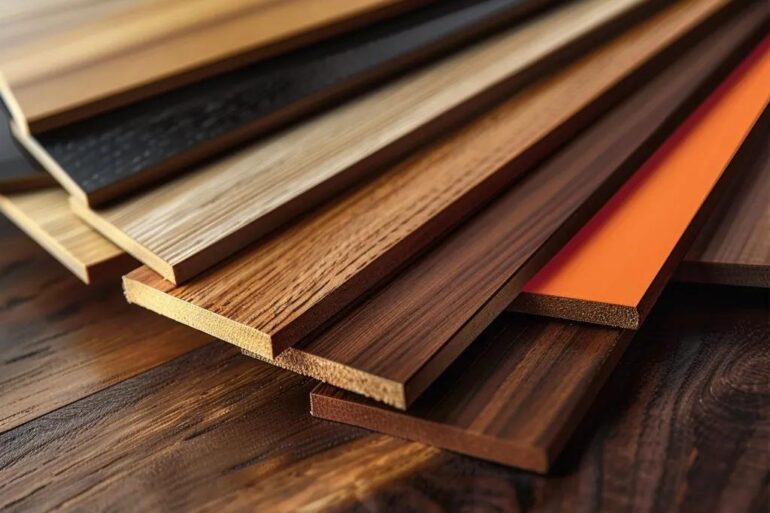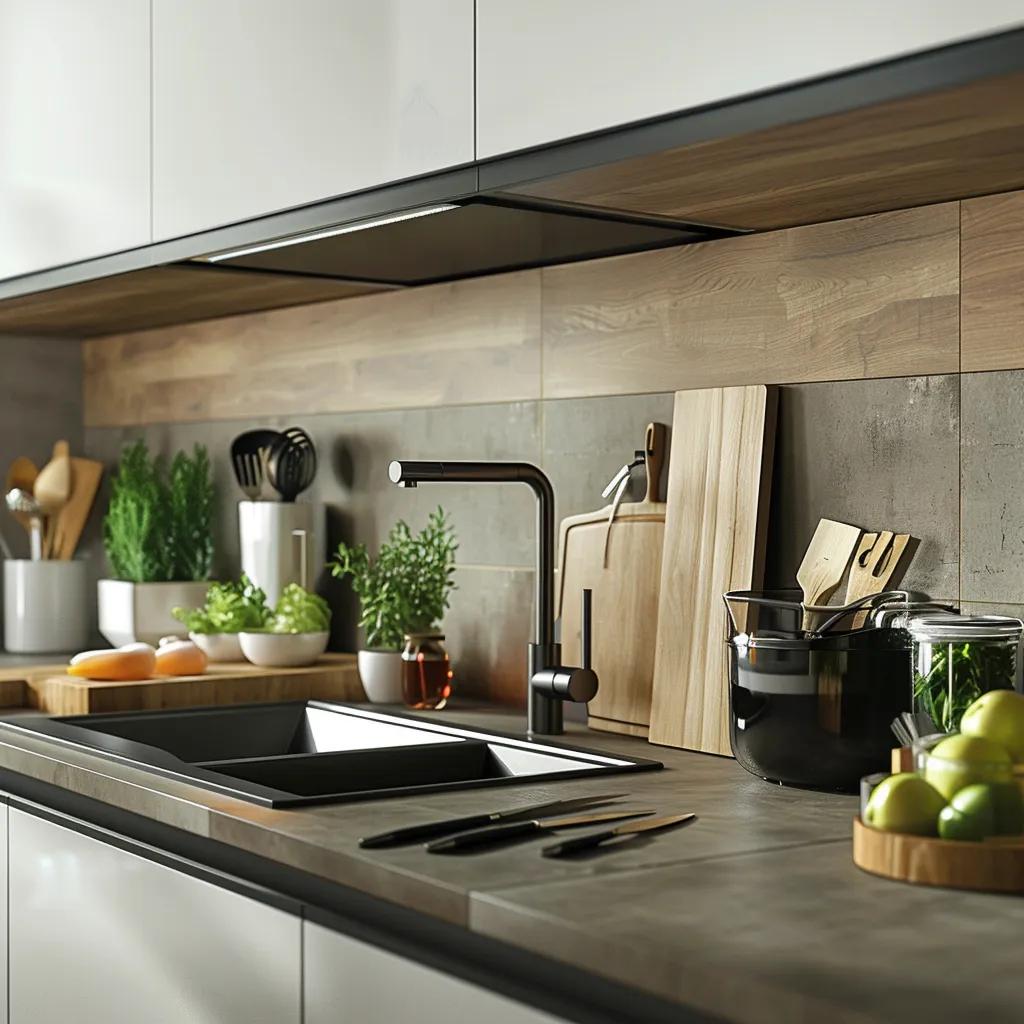
Maximize Design Success with Trumatch Edgebanding Guide
Trumatch edgebanding delivers seamless durability and refined aesthetics for design professionals who seek reliable edge protection and a polished finish. Architects and woodworkers often face edge chipping, moisture damage, and uneven finishes that undermine project longevity and appearance. This guide provides actionable insights into understanding Trumatch usage in design projects—from defining edgebanding essentials and comparing PVC, ABS, wood veneer, and specialty options to exploring real-world applications, performance benefits, selection criteria, installation techniques, and maintenance strategies. It covers key material properties, practical examples in kitchen cabinetry, commercial furniture, millwork, and residential interiors, and showcases successful case studies that drive leads and product inquiries. By mastering Trumatch edgebanding, design teams can boost durability, enhance visual continuity, and exceed client expectations. This foundation leads us to examine what Trumatch edgebanding is and why it is essential for design projects.
What Is Trumatch Edgebanding and Why Is It Essential for Design Projects?
Trumatch edgebanding is a thin, flexible strip applied to the exposed edges of wood-based panels to protect against wear and moisture while creating a continuous, factory-grade finish. By sealing panel edges with pre-glued PVC, ABS, or real wood veneer, it improves structural integrity, prevents swelling and maintains aesthetic harmony—an approach seen in high-end office millwork where edge integrity is critical. Understanding its protective role helps design professionals avoid premature damage and present flawless installations. This essential knowledge introduces the core materials behind Trumatch edgebanding.
What Are the Key Materials Used in Trumatch Edgebanding?
Trumatch edgebanding is crafted from PVC, ABS, and genuine wood veneer to suit diverse performance and aesthetic needs.
- PVC Edgebanding offers exceptional moisture resistance and color stability for wet environments.
- ABS Edgebanding provides impact protection and enhanced flexibility for heavy-traffic applications.
- Wood Veneer Edgebanding delivers authentic grain patterns and a premium look for upscale interiors.
Each material balances functionality and design intent to meet specific project requirements, setting the stage for how Trumatch edgebanding enhances overall durability.
Edgebanding Material Properties
Edgebanding materials like PVC, ABS, and wood veneer are chosen based on their specific properties to meet diverse project needs. PVC offers moisture resistance, ABS provides impact protection, and wood veneer delivers authentic aesthetics, each balancing functionality and design intent.
This research supports the article’s discussion of the different materials used in Trumatch edgebanding and their respective advantages.
How Does Trumatch Edgebanding Enhance Furniture and Architectural Durability?

Trumatch edgebanding boosts durability by forming a protective barrier that defends against moisture ingress, daily impact and edge chipping.
Durability and Performance of Edgebanding
Edgebanding significantly enhances the durability of furniture and architectural elements by acting as a protective barrier against moisture, impact, and wear. This protection prevents damage, ensuring the longevity and aesthetic appeal of the applied surfaces.
This citation reinforces the article’s claims about how Trumatch edgebanding improves the durability and longevity of design projects.
- Moisture Resistance prevents swelling of MDF and particleboard cores in kitchens and bathrooms.
- Impact Protection guards against dents and knocks in hospitality and commercial settings.
- Scratch Prevention preserves surface integrity under heavy use.
These performance features ensure that cabinetry, furniture and millwork retain structural strength and visual appeal over years of service.
Who Uses Trumatch Edgebanding in Design Projects?
Architects, interior designers, contractors, and woodworkers rely on Trumatch edgebanding to achieve seamless finishes, consistent edge protection, and streamlined installation workflows.
- Architects specify edgebanding for precision millwork and integrated design schemes.
- Interior Designers choose color-matched materials for cohesive aesthetics.
- Contractors benefit from pre-glued backing that speeds up assembly.
- Woodworkers appreciate the accurate grain matching and ease of trimming.
Understanding these user roles clarifies how each discipline leverages Trumatch edgebanding for project success and naturally leads to exploring material options.
Which Types of Trumatch Edgebanding Materials Best Suit Your Design Needs?
Selecting the right Trumatch edgebanding material involves matching attributes like durability, eco-friendliness, and visual impact to specific project conditions. For example, PVC excels in moisture-prone areas, ABS delivers robust impact resistance for high-traffic zones, and wood veneer brings authentic warmth to bespoke cabinetry. Assessing these material characteristics ensures optimal performance and design coherence. To guide your choice, the next sections examine PVC, ABS, wood veneer, and specialty finishes.
What Are the Properties and Applications of Trumatch PVC Edgebanding?
Trumatch PVC edgebanding provides a cost-effective solution with superior moisture and UV resistance, making it ideal for kitchen cabinetry, laboratory counters and restroom partitions. It adheres reliably to panel substrates, offers stain-resistant surfaces and is available in a wide palette of solid colors and wood-look patterns. For example, a white PVC edge on contemporary cabinets creates a crisp, modern aesthetic while resisting discoloration over time.
How Does Trumatch ABS Edgebanding Compare in Durability and Eco-Friendliness?
Trumatch ABS edgebanding combines enhanced impact strength with a lower environmental footprint compared to PVC, as it is fully recyclable and free of chlorine. Its flexible composition resists cracking under stress, making it suited for commercial office furniture, school desks and library shelving. By choosing ABS, design teams support sustainability goals without sacrificing performance.
What Are the Advantages of Trumatch Wood Veneer Edgebanding for Natural Aesthetics?
Trumatch wood veneer edgebanding offers authentic species-specific grain and texture for premium millwork and custom furnishings. Crafted from sustainably sourced veneers and backed with pre-glued substrate, it blends seamlessly with hardwood panels in conference tables, cabinetry facades and architectural wall panels. The genuine wood finish enriches tactile experience and elevates interior warmth.
What Specialty Edgebanding Options Does Trumatch Offer?
Trumatch delivers an array of specialty finishes—including metallic trims, textured surfaces and high-gloss lacquers—to meet avant-garde design demands. Metallic edgebanding accents reflect light in retail displays, textured edges add dimension to feature walls, and high-gloss options amplify contemporary furniture silhouettes. These curated finishes expand creative possibilities beyond conventional materials.
Comparative Table of Trumatch Edgebanding Materials
Below is a comparison of core Trumatch materials, their key features and ideal applications.
| Material Type | Key Feature | Ideal Use |
|---|---|---|
| PVC Edgebanding | Moisture resistance | Kitchens, labs, wet-use environments |
| ABS Edgebanding | Impact strength | Commercial office, schools, high-traffic |
| Wood Veneer Edgebanding | Authentic grain | Premium cabinetry, custom millwork |
| Metallic & Textured | Reflective/Dimension | Retail displays, feature walls |
This comparison clarifies how each Trumatch material aligns with project goals and design intents, guiding the next exploration of specific applications.
How Can Trumatch Edgebanding Be Applied Across Different Design Projects?

Trumatch edgebanding adapts to diverse design contexts by providing tailored protection, finish continuity and aesthetic integration. Whether in kitchens, commercial furniture, architectural millwork or residential interiors, it streamlines installation and elevates final presentation. Examining these applications illustrates practical benefits and inspires creative solutions.
How Is Trumatch Edgebanding Used in Kitchen Cabinetry Design?
In kitchen cabinetry, Trumatch edgebanding seals panel edges against steam and cleaning agents while unifying the cabinet surface with continuous color or wood grain. Pre-glued PVC and ABS edges reduce assembly time, ensure uniform joints and prevent moisture-related swelling. Designers often pair matching edge and door finishes to achieve a monolithic look that enhances perceived quality and resale value.
What Are the Benefits of Trumatch Edgebanding in Commercial Furniture Solutions?
Commercial furniture solutions benefit from Trumatch edgebanding’s impact resistance and low maintenance. Office desks, reception counters, and breakout tables use ABS and specialty finishes to withstand heavy use, minimize edge chipping, and simplify cleaning. The result is durable furniture that maintains a professional appearance under constant occupancy and frequent reconfiguration.
How Does Trumatch Edgebanding Enhance Architectural Millwork?
Architectural millwork gains precision and longevity when Trumatch edgebanding is applied to wall panels, columns, and built-in casework. Real wood veneer edges seamlessly blend with solid wood components, while PVC and ABS options protect exposed edges in high-touch areas like hotel lobbies. Consistent edge profiles reinforce joint integrity and contribute to a cohesive design narrative.
What Role Does Trumatch Edgebanding Play in Residential Interior Design?
In residential interiors, Trumatch edgebanding supports custom furniture, built-in shelving and feature wall treatments by providing exact grain and color matches that integrate with flooring, trims and cabinetry. Homeowners enjoy maintenance-free edges that resist daily wear, and designers leverage specialty finishes to accentuate contemporary décor themes. This adaptability makes Trumatch edgebanding a go-to solution for lasting residential quality.
What Are the Key Benefits and Performance Features of Trumatch Edgebanding?
Trumatch edgebanding delivers critical benefits—durability, moisture and impact resistance, seamless aesthetics and suitability for high-traffic areas—that meet stringent design and functional requirements. These performance features enhance project longevity and reduce lifecycle costs, earning trust from architects, designers and contractors. The following sections unpack each key advantage in detail.
How Does Trumatch Edgebanding Improve Durability and Longevity?
Trumatch edgebanding extends the lifespan of panel assemblies by shielding vulnerable edges from abrasion, knocks and moisture attack. Its robust composition and precision bonding prevent edge splitting and core delamination, ensuring furniture and casework endure daily use. Over time, this edge reinforcement reduces repair needs and extends asset value.
What Moisture and Impact Resistance Does Trumatch Edgebanding Provide?
Trumatch edgebanding resists water penetration and absorbs impact energy to prevent edge swelling and chipping. PVC variants create a watertight seal on kitchen cabinets and restroom partitions, while ABS edges flex under shock to protect high-traffic furniture. This dual resistance maintains both structural integrity and aesthetic consistency.
How Does Trumatch Achieve a Seamless and Aesthetic Edgebanding Finish?
Trumatch employs precision-calibrated backing and zero-joint laser trimming to produce edge profiles that align flawlessly with panel surfaces. This seamless finish eliminates visible glue lines and texture mismatches, delivering a factory-grade appearance. Designers benefit from a uniform edge that reinforces brand and design intent.
What Functional Advantages Make Trumatch Edgebanding Ideal for High-Traffic Areas?
Trumatch edgebanding stands up to intense use in environments like schools, hospitals, and corporate offices by combining scratch-resistant surfaces, impact-absorbing substrates, and easy-clean coatings. These functional advantages minimize downtime for repairs and maintain a professional look under constant occupancy.
How Do You Select and Specify the Right Trumatch Edgebanding for Your Project?
Choosing the correct Trumatch edgebanding involves evaluating thickness, width, color matching, sustainability credentials, and technical specifications to align with design objectives and performance standards. This selection process ensures optimal integration and compliance with industry requirements. The next sections outline practical guidelines for specifying your ideal edge solution.
What Thickness and Width Options Are Available for Trumatch Edgebanding?
Trumatch offers edgebanding from 0.5 mm to 3 mm in thickness and from 22 mm to 100 mm in width, plus custom sizes for unique profiles. Thinner edges suit lightweight furniture and delicate trim, while thicker strips provide robust protection on heavy-duty casework. Accurate sizing ensures edge coverage without excess material waste.
How Can You Match Trumatch Edgebanding Colors and Textures to Your Design?
Trumatch maintains a comprehensive color library with solid hues, woodgrain patterns, and specialty textures. Design teams can order physical sample chips or view digital color tools at Trumatch Edgebanding to verify precise matches. This ensures seamless integration of edges with panel faces and adjacent finishes.
What Sustainable and Eco-Friendly Trumatch Edgebanding Options Exist?
Sustainability-focused projects can specify ABS edgebanding—which is fully recyclable—and FSC-certified wood veneer options sourced from responsibly managed forests. These eco-friendly choices support green building certifications and corporate social responsibility goals without compromising edge performance.
What Technical Specifications Should Architects and Designers Consider?
Professional specifications must include edge material type, thickness, width, finish code, glue system (hot-melt or water-based) and fire-rating or VOC compliance if required. Clear technical data ensures accurate procurement, regulatory compliance and seamless coordination with fabricators and installers.
How Do You Properly Install and Maintain Trumatch Edgebanding for Lasting Success?
Correct installation and routine maintenance of Trumatch edgebanding preserve its protective and aesthetic qualities over time. Following best practices for application, cleaning and troubleshooting maximizes edge life and keeps surfaces looking new. The steps below guide successful installation and care.
What Are the Best Practices for Applying Trumatch Edgebanding?
Applying Trumatch edgebanding involves ensuring clean, straight panel edges, activating the pre-applied adhesive with calibrated heat or pressure, trimming excess material, and finishing edges with light sanding or laser trimming. Accurate temperature control and steady feed rates prevent bubbling and misalignment, resulting in a precise joint.
How Can You Maintain Trumatch Edgebanding to Preserve Appearance and Function?
Regular cleaning with non-abrasive detergents, periodic inspection of high-traffic areas and immediate repair of minor chips keep edges in top condition. Using recommended cleaning products prevents finish degradation, while preventive maintenance extends edge integrity and visual continuity.
How Do You Troubleshoot Common Edgebanding Issues with Trumatch Products?
For lifting or peeling edges, reheat the adhesive zone with a low-temperature iron and press firmly to re-bond. Minor surface scratches on PVC or ABS can be buffed out with fine abrasives, while veneer edges may require touch-up stains. These quick remedies restore edge performance without replacing the entire panel.
What Real-World Examples Demonstrate Trumatch Edgebanding Success in Design Projects?
Case studies of Trumatch edgebanding highlight measurable improvements in durability, client satisfaction and project aesthetics across diverse sectors. Showcasing these successes builds trust and inspires confidence for future leads.
Which High-Profile Projects Showcase Trumatch Edgebanding Applications?
Featured installations include a corporate headquarters’ reception desk where metallic PVC edges accent branding, a boutique hotel’s wood veneer-trimmed wall panels and a medical clinic’s moisture-proof cabinets. Each project demonstrates edge integrity under demanding use.
What Do Architects and Designers Say About Using Trumatch Edgebanding?
Design professionals praise Trumatch for its precise color matching, ease of installation and reliable performance. One architect notes that “Trumatch edgebanding transformed our millwork workflow, delivering flawless edges that stand the test of time.”
How Has Trumatch Edgebanding Improved Project Outcomes and Client Satisfaction?
Clients report up to 30% fewer repairs and ongoing maintenance issues, faster installation times, and enhanced visual continuity across complex assemblies. These measurable outcomes translate into higher return rates and stronger referrals, reinforcing Trumatch as a preferred edge solution.
By following this guide, design teams can confidently integrate Trumatch edgebanding throughout their projects, ensuring lasting durability, consistent aesthetics, and streamlined workflows that drive client satisfaction and new business inquiries.
Conclusion
Mastering Trumatch edgebanding empowers design professionals to achieve exceptional durability, seamless aesthetics, and enhanced project longevity. By understanding the diverse material options and their applications, architects, designers, and woodworkers can elevate their work while minimizing maintenance issues. Explore our extensive range of Trumatch edgebanding solutions to find the perfect fit for your next project. Start transforming your designs today with the reliability and style that Trumatch offers.
Frequently Asked Questions
What is the installation process for Trumatch edgebanding?
The installation of Trumatch edgebanding involves several key steps to ensure a successful application. First, ensure that the panel edges are clean and straight. Next, activate the pre-applied adhesive using calibrated heat or pressure. Trim any excess material carefully, and finish the edges with light sanding or laser trimming for a seamless look. Proper temperature control and steady feed rates during application are crucial to prevent bubbling and misalignment, resulting in a precise joint that enhances the overall finish.
How can Trumatch edgebanding be maintained for longevity?
To maintain Trumatch edgebanding and preserve its appearance, regular cleaning with non-abrasive detergents is recommended. Periodic inspections of high-traffic areas can help identify any wear or damage early. Immediate repair of minor chips or scratches is essential to prevent further deterioration. Using the recommended cleaning products will prevent finish degradation, while routine maintenance will extend the integrity and visual continuity of the edges, ensuring they remain in top condition over time.
What are the common troubleshooting tips for Trumatch edgebanding issues?
If you encounter issues such as lifting or peeling edges, a low-temperature iron can be used to reheat the adhesive zone, allowing you to press the edge back into place. For minor surface scratches on PVC or ABS materials, buffing with fine abrasives can help restore the finish. In the case of wood veneer edges, touch-up stains may be necessary to maintain their appearance. These quick fixes can effectively restore edge performance without the need for complete panel replacement.
What are the eco-friendly options available in Trumatch edgebanding?
Trumatch offers several eco-friendly edgebanding options, particularly focusing on sustainability. The ABS edgebanding is fully recyclable, making it a great choice for environmentally conscious projects. Additionally, Trumatch provides FSC-certified wood veneer options sourced from responsibly managed forests. These sustainable choices not only support green building certifications but also align with corporate social responsibility goals, allowing designers to meet performance standards without compromising on environmental impact.
How does Trumatch edgebanding contribute to design aesthetics?
Trumatch edgebanding significantly enhances design aesthetics by providing a seamless and polished finish that integrates well with various materials. The precision-calibrated backing and zero-joint laser trimming techniques ensure that edges align flawlessly with panel surfaces, eliminating visible glue lines and texture mismatches. This attention to detail results in a factory-grade appearance that reinforces the overall design intent, allowing architects and designers to achieve cohesive and visually appealing installations across different projects.
What types of projects benefit most from using Trumatch edgebanding?
Trumatch edgebanding is versatile and can be applied across a wide range of projects, including kitchen cabinetry, commercial furniture, architectural millwork, and residential interiors. Its durability and aesthetic appeal make it particularly beneficial in high-traffic areas such as schools, hospitals, and corporate offices, where it can withstand daily wear and tear. Additionally, its ability to provide a cohesive look makes it ideal for custom furniture and feature wall treatments, enhancing both functionality and design quality.
